Quantitative Study of Internal Defects in Copper Iron Alloy Materials Using Computed Tomography
Abstract
1. Introduction
2. Experimental Process and Methods
2.1. Materials and Processes
2.2. CT Testing
2.3. Numerical Simulation of Semi-Continuous Casting Mold
3. Results and Analysis
3.1. Surface Defects on the Strip
3.2. Characteristics of Internal Defects
3.3. Quantitative Analysis of Defects
3.4. Relationship Between Defect Formation and Process
3.5. Relationship Between Defect Formation and Alloy
4. Conclusions
- (1)
- The internal defects in the horizontal continuous cast Cu-Ni-Sn slab are primarily small point-like; there are mainly point-like defects in the semi-continuous casting Cu-Fe alloy slab, with irregular and large-sized pores apparent. When the Cu-Fe alloy slab undergoes hot rolling, the size of the pore defects increases.
- (2)
- Compared with the as-cast Cu-Ni-Sn slab, the Cu-Fe alloy slab through hot rolling has a similar spherical distribution of internal defects, with the main difference being the low spherical degree (<0.4). The volume of internal porosity defects in the hot-rolled Cu-Fe alloy slab is significantly larger, exhibiting a 52-fold difference. This phenomenon may be a source of the surface defects during subsequent cold-rolling processes.
- (3)
- The solubility of O in molten iron is higher than that in molten copper, which may lead to an increase in the dissolved O content in Cu-Fe alloys with high Fe content; Compared with the horizontal continuous casting, the solidification rate is slower in the semi-continuous casting, resulting in an increase in the internal porosity volume (tissue porosity) within the slab. Controlling the size of the porosity defects in the Cu-Fe alloy slab and the hot-rolling process to reduce internal defects are crucial measures for improving product surface quality.
Author Contributions
Funding
Data Availability Statement
Acknowledgments
Conflicts of Interest
References
- Wang, M.; Jiang, Y.; Li, Z.; Xiao, Z.; Lei, Q. Microstructure Evolution and Deformation Behaviour of Cu-10 wt%Fe Alloy during Cold Rolling. Mater. Sci. Eng. A 2021, 801, 140379. [Google Scholar] [CrossRef]
- Yuan, D.; Xiao, X.; Luo, X.; Wang, H.; Han, B.; Liu, B.; Yang, B. Effect of Multi-Stage Thermomechanical Treatment on Fe Phase Evolution and Properties of Cu-6.5 Fe-0.3 Mg Alloy. Mater. Charact. 2022, 185, 111707. [Google Scholar] [CrossRef]
- Liu, S.; Jie, J.; Guo, Z.; Yue, S.; Li, T. A comprehensive investigation on microstructure and magnetic properties of immiscible Cu-Fe alloys with variation of Fe content. Mater. Chem. Phys. 2019, 238, 121909. [Google Scholar]
- Zhang, P.; Lei, Q.; Yuan, X.; Sheng, X.; Jiang, D.; Li, Y.; Li, Z. Microstructure and mechanical properties of a Cu-Fe-Nb alloy with a high product of the strength times the elongation. Mater. Today Commun. 2020, 25, 101353. [Google Scholar] [CrossRef]
- Guo, J.; Hu, Q.; Zou, J.; Lu, D. Effect of Cooling Rate on Morphology and Distribution of Fe Phase in Solidification Structure of Cu-20Fe Alloy. Metall. Res. Technol. 2023, 120, 312. [Google Scholar] [CrossRef]
- Wen, J.; Yan, C.; Wang, W.; Guo, C.; Zhou, B.; Liang, J.; Sun, J.; Wang, Q.; Li, X. Microstructure and Properties of Cu-5Fe Alloy Thin Strip and Foil. Spec. Cast. Nonferrous Alloys 2022, 42, 1012–1015. [Google Scholar]
- Zhang, P.; Yu, Z.; Wang, Y.; Zhou, L.; Zhang, Z. Research Progress on Strengthening Mechanism of Copper-Iron Alloys with High Iron Concentration. Chin. J. Nonferrous Met. 2023, 33, 2496–2520. [Google Scholar]
- Zhang, K.; Meng, Q.; Zhang, X.; Qu, Z.; He, R. Quantitative Characterization of Defects in Stereolithographic Additive Manufactured Ceramic Using X-ray Computed Tomography. J. Mater. Sci. Technol. 2022, 118, 144–157. [Google Scholar] [CrossRef]
- Qian, Q.; Zhang, X.; Yang, Z.; Sheng, Z.; Xiao, J. Intelligent Identification of Micro Components and Defects of 3D Braided C/C Composites Based on Deep Learning of X-ray CT Images. Acta Mater. Compos. Sin. 2024, 41, 3536–3543. [Google Scholar]
- Nicoletto, G.; Konečná, R.; Fintova, S. Characterization of Microshrinkage Casting Defects of Al–Si Alloys by X-ray Computed Tomography and Metallography. Int. J. Fatigue 2012, 41, 39–46. [Google Scholar] [CrossRef]
- Sun, I.H. Copper-Iron Filamentary Microcomposites. Adv. Eng. Mater. 2010, 3, 475–479. [Google Scholar]
- Sun, B.; Gao, H.; Wang, J.; Shu, D. Strength of Deformation Processed Cu-Fe-Ag In Situ Composites. Mater. Lett. 2007, 61, 1002–1006. [Google Scholar] [CrossRef]
- Maire, E.; Withers, P.J. Quantitative X-ray Tomography. Int. Mater. Rev. 2014, 59, 1–43. [Google Scholar] [CrossRef]
- Zheng, X.; Wang, Y.; Jin, J. Numerical Simulation of Temperature Field of Semi-Continuous Casting of Slab in EMC. Acta Metall. Sin. 1999, 861–864. [Google Scholar]
- Luo, H.J.; Jie, W.Q.; Gao, Z.M.; Zheng, Y.J. Numerical Simulation of the Influence of Casting Parameters on Macroscopic Segregation in 2024 Aluminum Alloy Semi Continuous Casting Process. Rare Met. Mater. Eng. 2018, 25, 1007–1015. [Google Scholar]
- Chuang, C.; Singh, D.; Kenesei, P.; Almer, J.; Hryn, J.; Huff, R. 3D Quantitative Analysis of Graphite Morphology in High Strength Cast Iron by High-Energy X-ray Tomography. Scr. Mater. 2015, 106, 5–8. [Google Scholar] [CrossRef]
- Diener, S.; Franchin, G.; Achilles, N.; Kuhnt, T.; Rössler, F.; Katsikis, N.; Colombo, P. X-Ray Microtomography Investigations on the Residual Pore Structure in Silicon Nitride Bars Manufactured by Direct Ink Writing Using Different Printing Patterns. Open Ceram 2021, 5, 100042. [Google Scholar] [CrossRef]
- Zhang, L.; Wang, S.; Liu, J.; Song, H.; Liu, Y. Research on Horizontal Continuous Casting Process of Copper Strip and Casting Slab Defects. Nonferrous Met. Mater. Eng. 2024, 45, 70–75. [Google Scholar]
- Liu, H.Q.; Yang, Q.; Wang, X.C.; Wang, L.S. Wear Contour Prediction Model and Application of the Work Roll in Hot Wide Strip Mill. Steel Roll 2018, 35, 45–49. [Google Scholar]
- Sonboli, A.; Serajzadeh, S. A Model for Evaluating Thermal Mechanical Stresses Within Work-Rolls in Hot-Strip Rolling. J. Eng. Math. 2012, 72, 73–85. [Google Scholar] [CrossRef]
- Ding, J.G.; Li, J.; Zhang, K.; Sun, J. Investigation on Contact Pressure of Backup Roll with Parabolic Chamfer Curve and Intelligent Modeling of Plate Crown in Plate Rolling Process. Int. J. Adv. Manuf. Technol. 2023, 127, 5633–5650. [Google Scholar] [CrossRef]
- Liu, Y.; Zhao, J.; Xiong, S.; Shu, L.; Sun, J. Effect of Production Process of JCC-6M-T Alloy on Microstructure and Properties. Copp. Eng. 2022, 4, 16–20. [Google Scholar]
- Luo, Y.; Li, H.; Yang, H.; Yang, Z.; Li, C.; Liu, S.; Chen, Q.; Xu, W.; Zhang, W.; Tan, X. Critical Role of Dissolved Oxygen and Iron–Copper Synergy in Dual-Metal/Char Catalyst Systems. Environ. Sci. Nano 2024, 11, 2091–2102. [Google Scholar] [CrossRef]
- Samarin, A.M.; Fedotov, V.P. On the Solubility of Oxygen in Liquid Nickel and in Iron-Nickel Alloys. Izvest. Akad. Nauk S.S.S.R. Otdel. Tekh. Nauk 1956, 222–223. [Google Scholar]
- Chen, Y.; Kuxman, U. A New Method of Calculation for the Solubility Minimum in Oxide-Metal Equilibria. J. Cent. South Inst. Min. Metall. 1990, 21, 479–484. [Google Scholar]



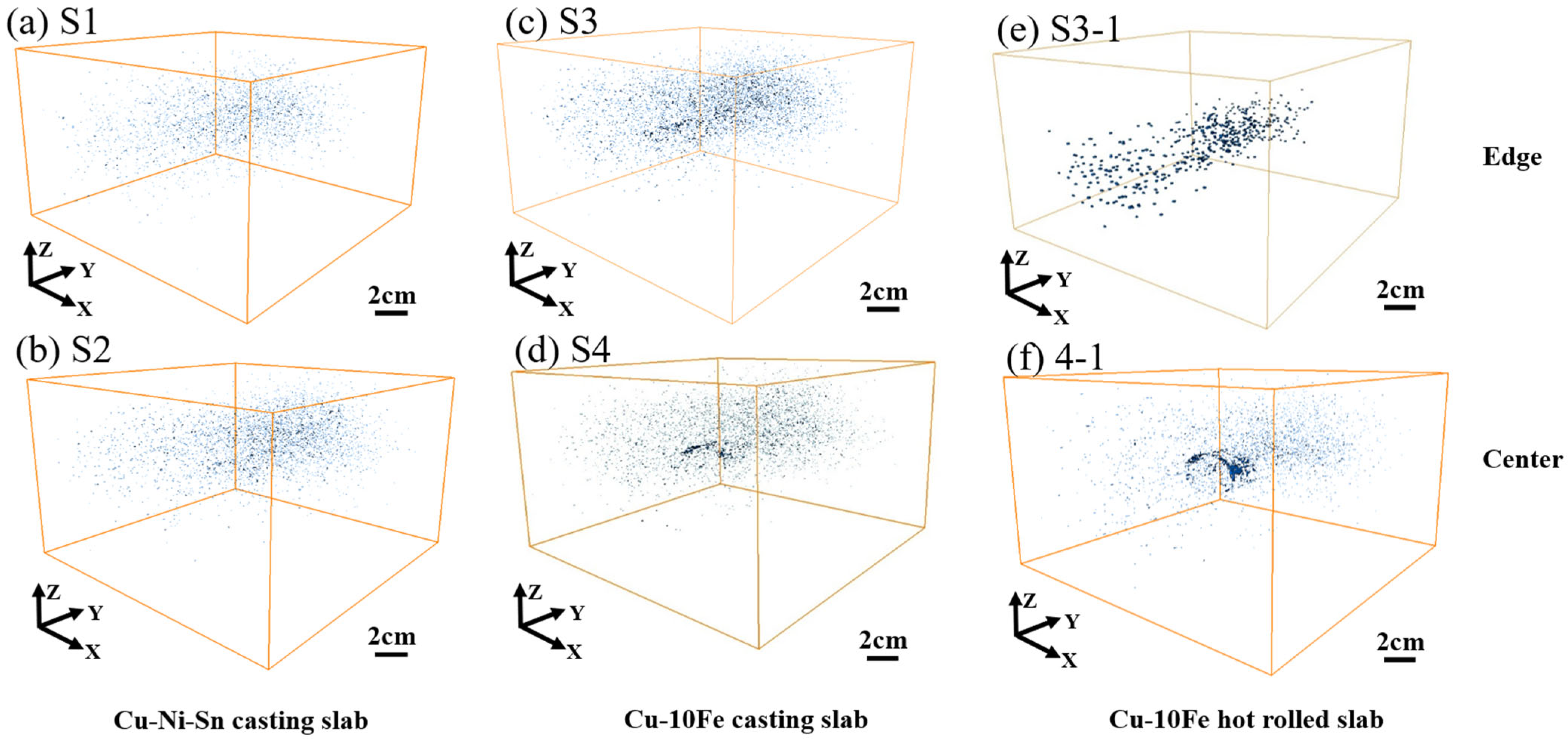
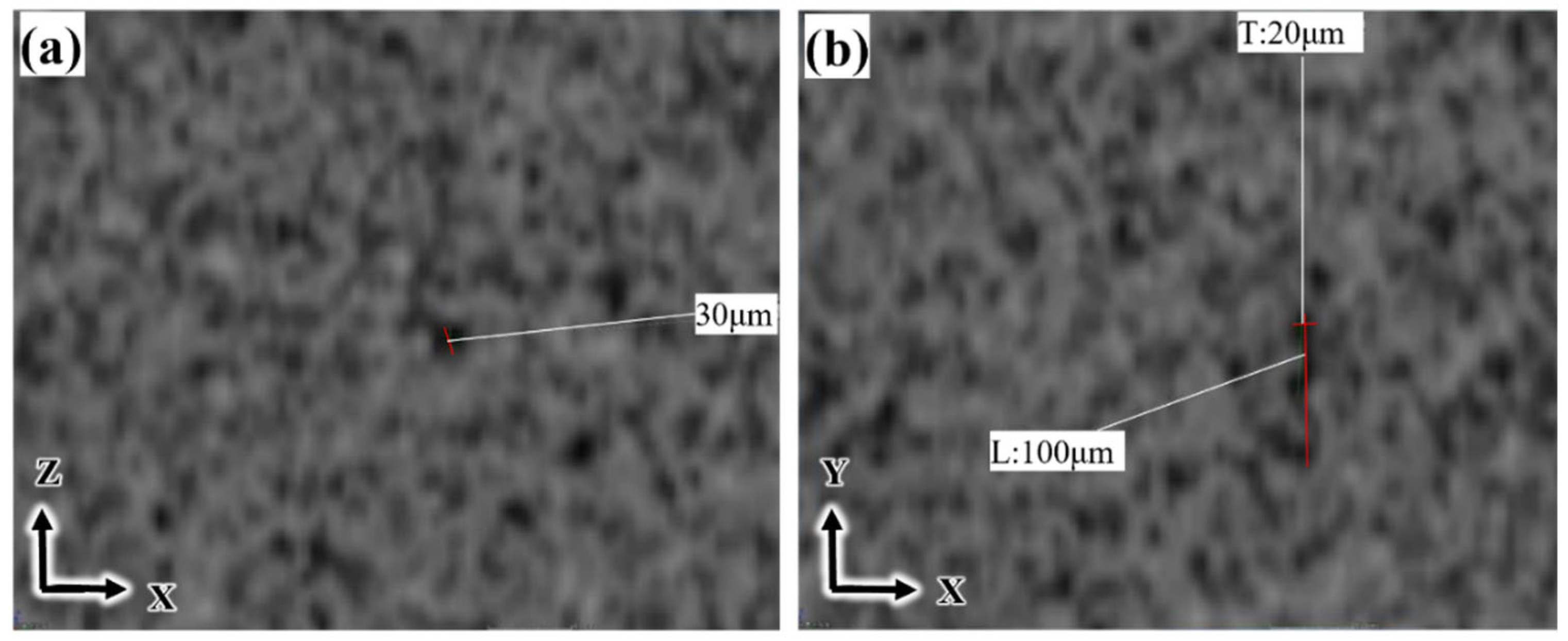




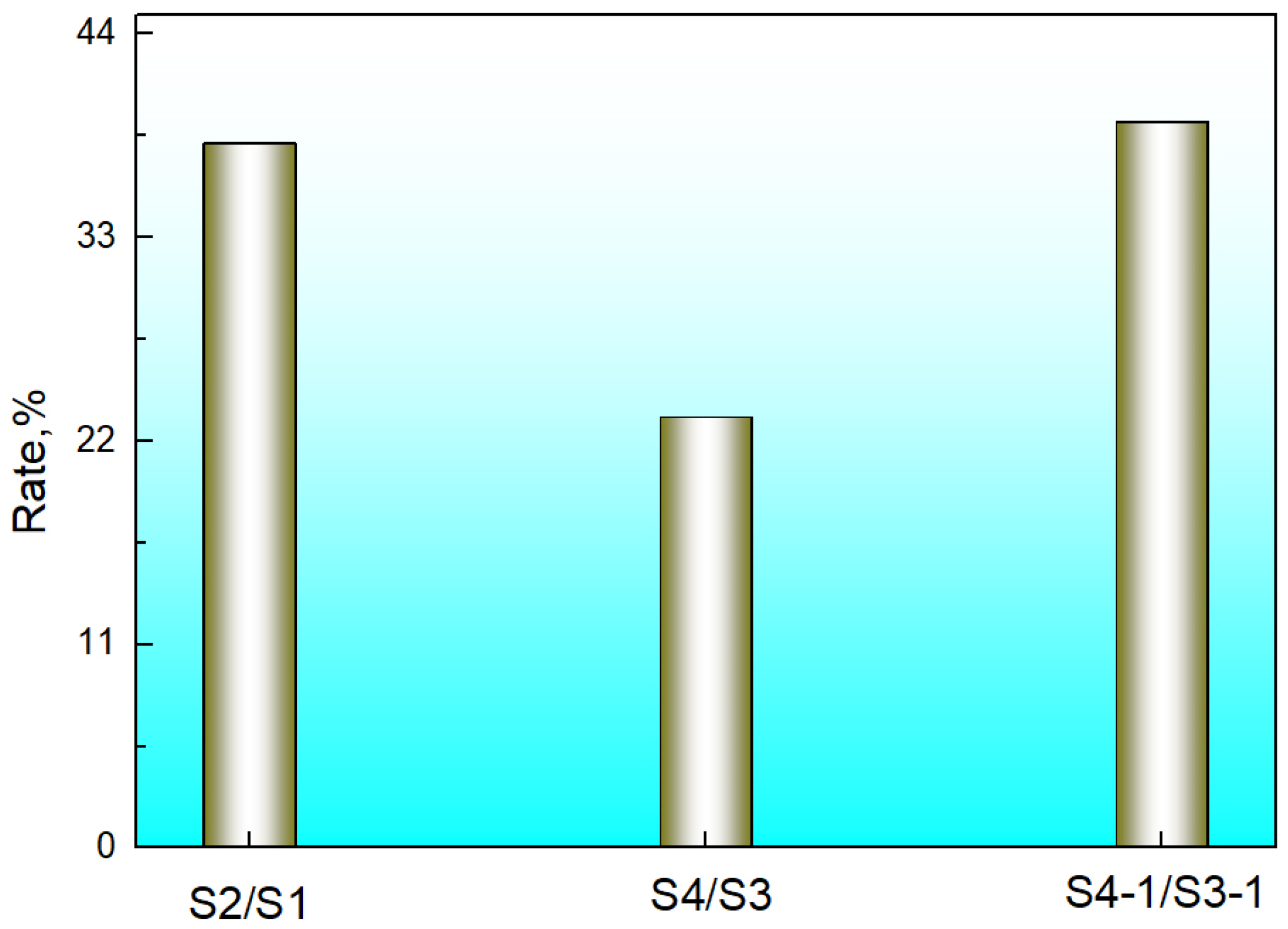
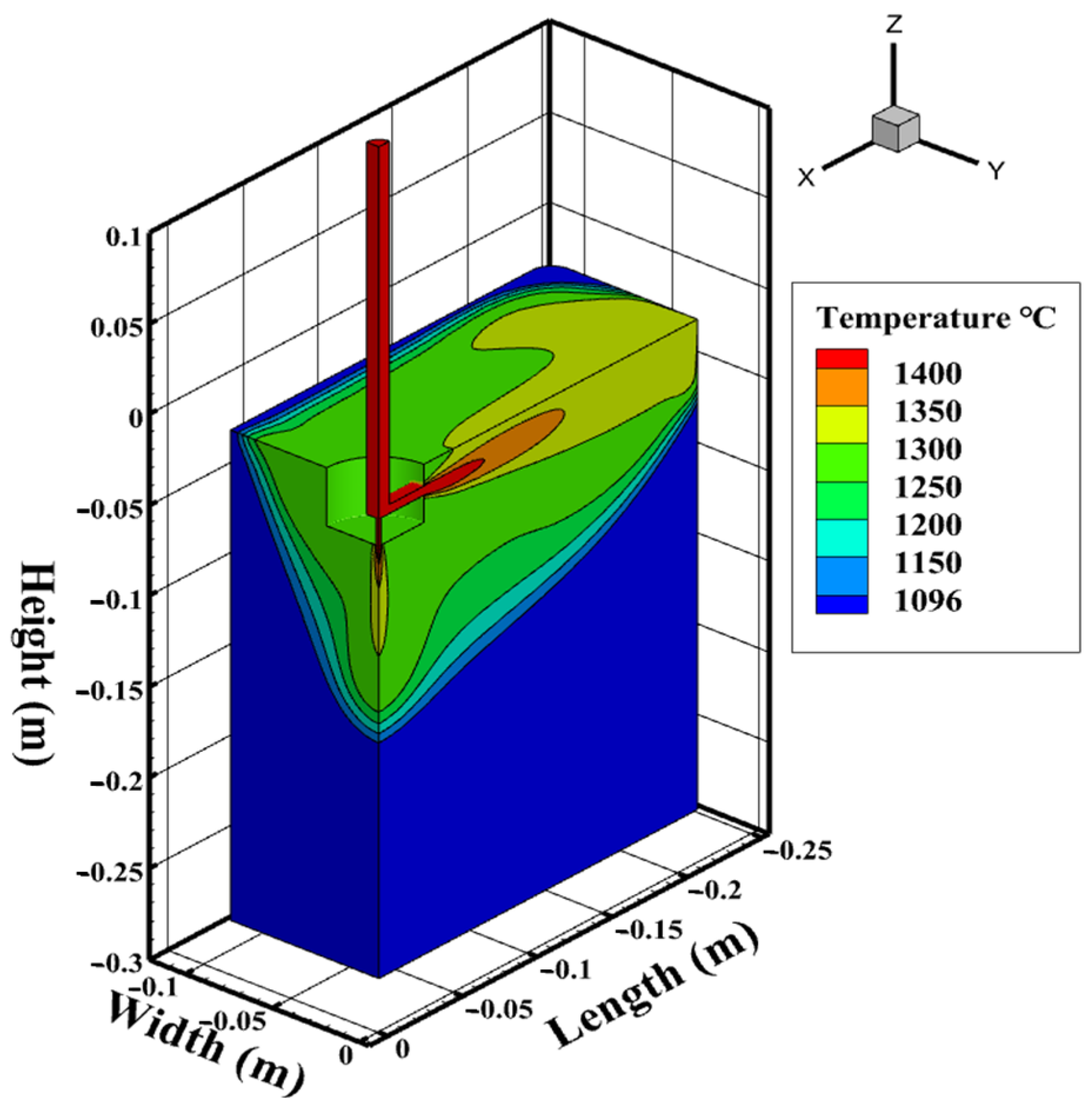
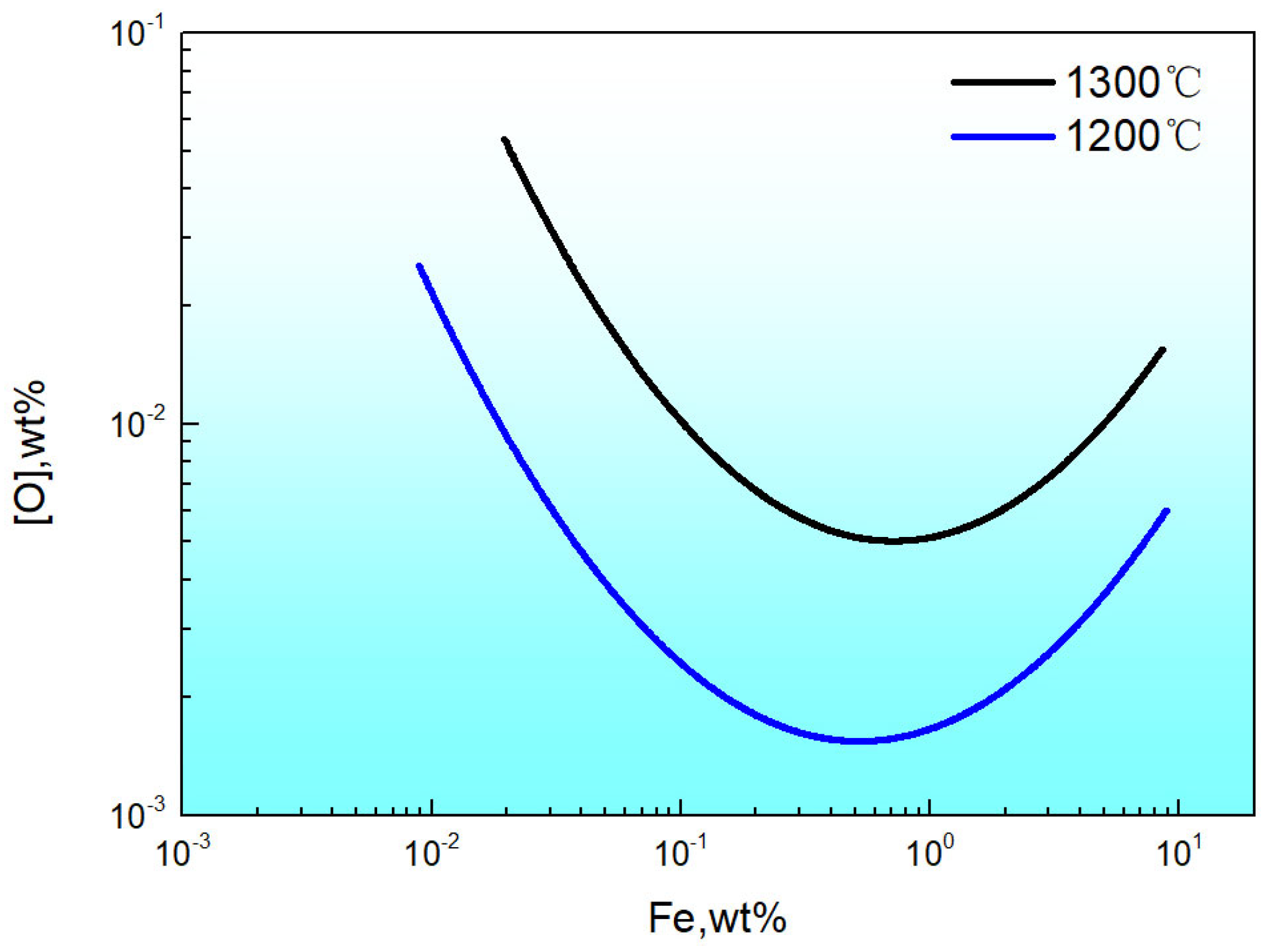
| Element | Sn | Ni | Fe | P | Cu |
|---|---|---|---|---|---|
| Cu-Ni-Sn alloy | 1.65 | 0.72 | 0.0013 | 0.065 | Bal |
| Cu-Fe alloy | — | — | 9.85 | 0.027 | Bal |
| Properties | Value |
|---|---|
| Liquidus/°C | 1270 |
| Solidus/°C | 1096 |
| Latent heat/KJ/kg | 212.2 |
| Density/kg/m3 | 7559.0 |
| Liquid viscosity/Pa·s | 4.3 × 10−3 |
| Copper Alloy Composition | Cu-10Fe |
|---|---|
| Mold size/mm × mm | 420 × 160 |
| Mold height/mm | 270 |
| Casting speed/mm∙min−1 | 45 |
| Casting temperature/°C | 1450 |
| Serial | S1 | S2 | S3 | S4 | S3-1 | S4-1 |
|---|---|---|---|---|---|---|
| 1 | 1.5 × 106 | 2.7 × 106 | 6.9 × 106 | 1.9 × 107 | 3.8 × 107 | 1.4 × 108 |
| 2 | 1.2 × 106 | 1.5 × 106 | 3.1 × 106 | 1.2 × 107 | 1.5 × 107 | 2.6 × 107 |
| 3 | 9.7 × 105 | 1.2 × 106 | 3.1 × 106 | 1.2 × 107 | 3.2 × 106 | 1.9 × 107 |
| 4 | 8.8 × 105 | 1.2 × 106 | 2.2 × 106 | 1.1 × 107 | 2.4 × 106 | 1.0 × 107 |
| 5 | 8.4 × 105 | 9.1 × 105 | 1.9 × 106 | 1.1 × 107 | 2.2 × 106 | 6.7 × 106 |
| Alloy | H (ppm) | O (ppm) |
|---|---|---|
| Cu-Ni-Sn | <5 | 64 |
| Cu-10Fe | <1 | 220 |
Disclaimer/Publisher’s Note: The statements, opinions and data contained in all publications are solely those of the individual author(s) and contributor(s) and not of MDPI and/or the editor(s). MDPI and/or the editor(s) disclaim responsibility for any injury to people or property resulting from any ideas, methods, instructions or products referred to in the content. |
© 2025 by the authors. Licensee MDPI, Basel, Switzerland. This article is an open access article distributed under the terms and conditions of the Creative Commons Attribution (CC BY) license (https://creativecommons.org/licenses/by/4.0/).
Share and Cite
Guo, J.; Hu, Q.; Hu, K. Quantitative Study of Internal Defects in Copper Iron Alloy Materials Using Computed Tomography. Alloys 2025, 4, 8. https://doi.org/10.3390/alloys4020008
Guo J, Hu Q, Hu K. Quantitative Study of Internal Defects in Copper Iron Alloy Materials Using Computed Tomography. Alloys. 2025; 4(2):8. https://doi.org/10.3390/alloys4020008
Chicago/Turabian StyleGuo, Junli, Qiang Hu, and Kai Hu. 2025. "Quantitative Study of Internal Defects in Copper Iron Alloy Materials Using Computed Tomography" Alloys 4, no. 2: 8. https://doi.org/10.3390/alloys4020008
APA StyleGuo, J., Hu, Q., & Hu, K. (2025). Quantitative Study of Internal Defects in Copper Iron Alloy Materials Using Computed Tomography. Alloys, 4(2), 8. https://doi.org/10.3390/alloys4020008






